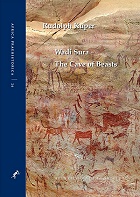

The Cave of Beats,
a new Rock Art Site in the Western Gilf Kebir
Late January 2003 Zarzora Expeditions and Jacopo Foggini separately announced the discovery of a major new rock art site in the Western Gilf Kebir. In February 2003 we have located and visited this amazing shelter. This page is intended to provide a preview of the site.
The site is a large semicircular shelter, not unlike the big cave at Wadi Sora, just even larger in dimensions. The rear wall is fully covered with paintings of the classic Wadi Sora style.
A unique feature of the site is the innumerable negative hand prints, and the many strange headless animals of which one damaged example remains at Wadi Sora (and another well preserved at a site nearby). It has been suggested that perhaps it's a mythical 'rain creature'. There are several little 'swimmer' figures associated with the strange creatures.
There is an immense amount of fine detail, full publication will take several volumes and hundreds of photos.
Another unique feature is the combination of engravings and paintings. There are even figures that are half painted, half engraved.
In 2003, ten years after its discovery the Heinrich Barth Institute published the first of a planned series of volumes on the Cave of Beasts, containing high resolution photographs of the entire site in 1:2 resolution:
 |
Rudolph Kuper WADI SURA – THE CAVE OF BEASTS A rock art site in the Gilf Kebir (SW Egypt) In collaboration with Franziska Bartz, Erik Büttner, Frank Darius, Frank Förster, Sabine Krause, Hans Leisen, Heiko Riemer, Jürgen Seidel and András Zboray AFRICA PRAEHISTORICA 26, Köln 2013 513 pp, 445 full colour pages, numerous coloured figures, tables and maps size 24 x 34 cm, hardcover and half linen-bound, 3 folded plates To order please continue to the book page |
| 70 years after the discovery of the famous “Cave of Swimmers” in the heart of the Libyan Desert by the “English Patient” László Almásy, only 10 km further west along the edge of the Gilf Kebir plateau, Massimo and Jacopo Foggini detected another painted shelter which – with its exceedingly rich and complex imagery – clearly surpasses all comparable rock art sites in Egypt, if not in the entire Sahara. About 8000 single figures, among them numerous hybrid creatures that inspired its name, “The Cave of Beasts”, offer unique insights into daily life and spirituality of a so far unknown past cultural world of about 8000 years ago and certainly range this shelter among the most important prehistoric sites of the continent. In order to make this extraordinary cultural heritage broadly accessible for scientific studies as well as for the larger public, an interdisciplinary research project was launched in 2009, financed by the German Research Council (DFG), which aims at a comprehensive documentation of the rock art as well as at its placement in the archaeological context of the surrounding landscape. In summer 2013, the first of three planned volumes will be published, presenting on 220 double pages the complete picture trove of Wadi Sura II in scale 1:2, based on high resolution digital photography and straightened by 3D laser scanning. The volume will be supplemented by 13 articles dealing with the context of the pictures and their archaeological setting. | |